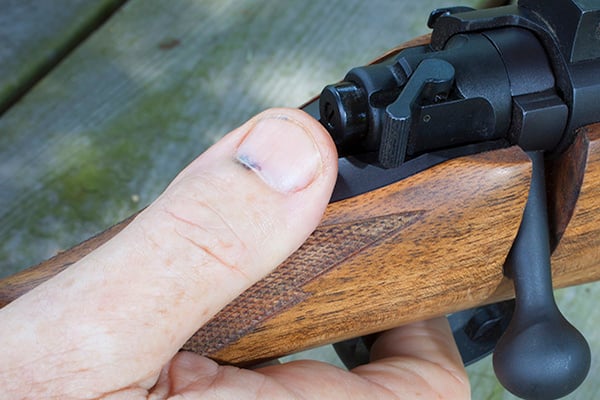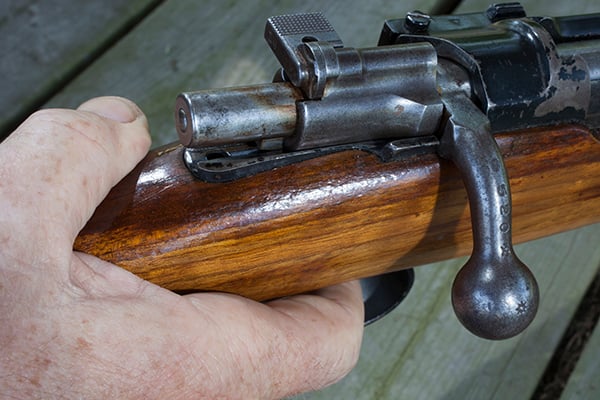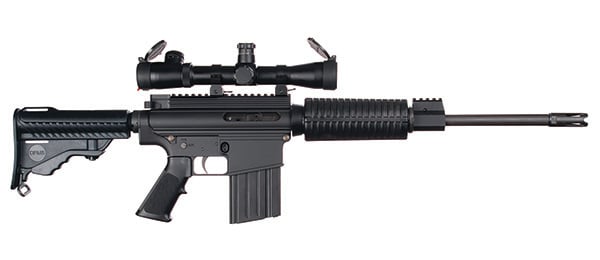
Last Updated on
By Guy Sagi
It may be the result of a death grip on a precision rifle’s wrist, sympathetic movement as the trigger finger begins its press or torqueing during the process, but your famously opposable digit could be doing you a disservice at distance and there’s a scientific reason.
Whether you are behind a not-so-gracefully aging rimfire or a sleek and modern high-caliber tack driver punching tiny groups of holes in paper—regardless of distance—it’s the simplest and purest form of shooting pleasure. It means you’re doing everything right, the ammunition choice was a wise one and the firearm is performing properly.
Of course, we all wish we could deliver those shots with a little more precision, and a few years ago, an instructor at SIG Sauer Academy gave me a tip that helped significantly. I wasn’t a bad shot at the time, but he diagnosed a nasty habit immediately, and once it was remedied, my groups shrunk by at least .1 MOA—actually more. One tenth of an inch at 100 yards may not sound like much, but the number of “flyers” I suffer has also gone down, I’m a lot more consistent and ammunition was the only investment required to improve.

All he did was move my thumb position when I settled into the gun and shot. Perhaps I was holding it across the stock’s wrist at a white-knuckled pressure hoping to avoid scope eye if the gun turned super hero and leaped from the bench, or he may have seen a slight shift in the gun as I pressed the trigger. I’d like to think the latter because my support arm never touches the rifle when working long distance.

Either way, I now place my dominant-side thumb very lightly on the side of the stock, pointed in the direction I’m shooting—not wrapped around the wrist toward my support side—which minimizes its ability to apply pressure. As a bonus, it’s reduced the amount of stock the base of my trigger finger encounters when engaged (so-called wood scraping). This may be peculiar to my hand and stock sizes, but my finger’s entry into the triggerguard is also more perpendicular than oblique, yet another side effect that makes travel a little more buttery smooth.

You may think you’re immune to any thumb-induced pressure during firing, like I did, but there’s some science that disagrees. A study published in the Nov. 15, 2000, Journal of Neuroscience, called “Quantifying the Independence of Human Finger Movements: Comparisons of Digits, Hands, and Movement Frequencies,” explains, “We found that even when asked specifically to move one digit without moving any other digits, normal human subjects produced low-amplitude motion in noninstructed digits simultaneous with the large-amplitude motion of the instructed digit.” The good news is the index finger, thumb are the most independent from the phenomena, and the slower the deliberate motion (trigger press), the less pronounced the communication misfire was.

The muscles, tendons and cartilage that run the show are also in very close proximity and often interconnected, too. “Limited independent flexion of the thumb and fingers in human subjects,” which was printed in a 1994 edition of The Journal of Physiology, identified some of that and even dissected cadavers to measure proximity and adjoining tissue. Its discussion section sums things up pretty well with: “The present study has shown that human subjects have a limited ability to contract selectively ‘muscles’ which flex the distal interphalangeal [that’s fingers and thumb] joints of the digits.” There is an obligatory coactivation of other deep digital flexor muscles: this coactivation increases when the digit flexes at a greater velocity or through a larger angle.”

It may be common sense that an index finger and thumb accustomed to years of grabbing things with tweezer-like precision instinctively move together, even if imperceptibly, but this pair of studies add a sound scientific foundation to the belief. Both also make a great case for slow trigger presses and even a good argument for a match-grade trigger with the observation that the heavier the weight being lifted by a finger, the greater the movement/pressure in adjacent digits.

Can it really make a big difference? There are many other factors at play, but a theoretical rifle with a 36-inch barrel puts the question into perspective. Attach the back of the barrel to an unmovable anchor and put the crosshair on a bullseye 100 yards away. If, as you squeeze the shot, the muzzle end somehow moves .01 inch (that’s 1/100) left, the hypothetical bullet will be slightly more than one inch off target at that distance. The math works out to be error per yard (.01/yard, which was the barrel length for simplicity) times yards traveled (100), plus initial error (.01 inside the barrel), or 1.01 inch. It’s already not shooting MOA, but add that tiny error to the right on the next shot and you’ve doubled the two-shot group and the gun is probably out to permanent pasture.

Both of the studies found the amount of inadvertent adjacent finger and thumb movement varied widely among test subjects, and the latter also found that in all but one test subject, involuntary movement reduced with repetition (we call that practice). That fact was on display hundreds of years ago with serious guitarists and piano players, who also face the finger co-movement challenge. Successful ones practice and exercise their way out of it.

I know some great shooters who have done the same today. There are those who stay with the wraparound technique and regularly outclass me during shooting seminars (a few play the piano well, coincidentally). Others ride the tang with great success, although I don’t like the fact it won’t work on every rifle in my safe. Most of them are at long-distance events a lot more than I am, though, so I’m content with a simple approach that cheats a heavy practice schedule and remedies my bad habit.

All three of my oldest grandsons learned to shoot a rifle with this technique, unlike the way I was taught with a tight, wraparound hold. Two of them are currently in the U.S. Army. One has already served in the Sand Box as a designated marksman, the middle one was second in his basic class in marksmanship, and the third, currently in ROTC, earned the nickname “The Assassin” at the range from his classmates (as a freshman).
It does not work well for everyone, but I wish I had met that wonderful instructor years before. I’ve seen the results when shooters start this way early, and it’s amazing.

The next time you’re at the range with a traditionally stocked rifle, give it a whirl. You may be as pleasantly surprised as I was after 40 rounds, and if nothing else, really impressed at how it gets young shooters on target, and excited about the next range session.
All photos by Guy Sagi (except photo courtesy of DPMS).




Leave a Reply